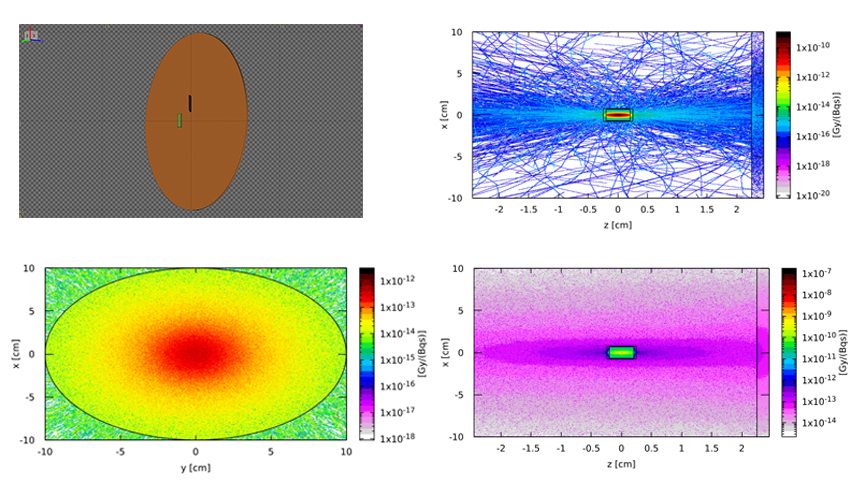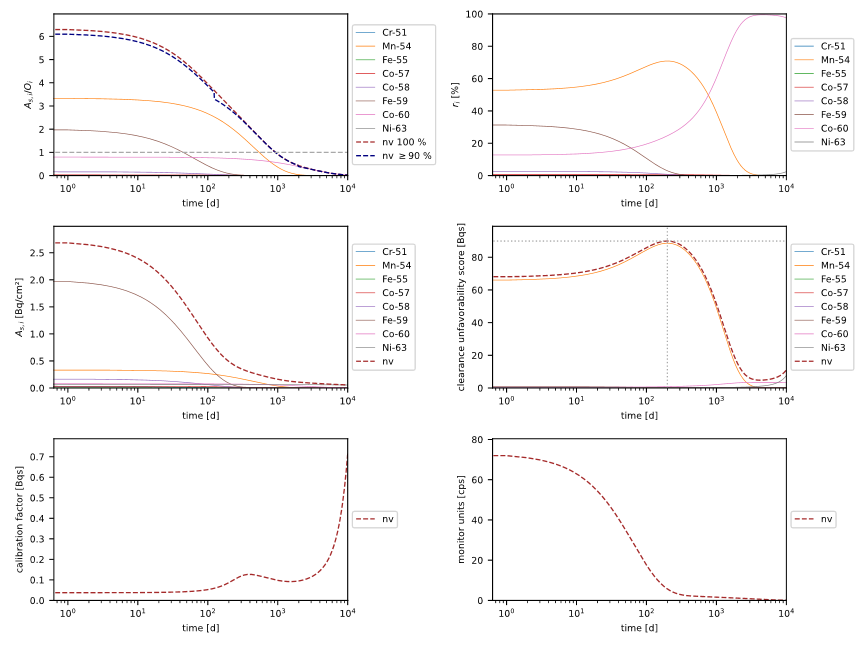The Saxon Network for Radionuclide Theranostics (SNRT) is dedicated to the development, production and application of radionuclide-labeled drugs (radiopharmaceuticals) for the European market. As a research partner, the VKTA is responsible for the radiological evaluation of nuclides for diagnostic and therapeutic purposes as well as production-related impurities and the management for their disposal in strict compliance with radiation protection regulations.
We use both measuring and calculation methods (e.g. gamma spectroscopy, decay calculations, compartment/ material transport modeling, Monte Carlo radiation transport simulation) to determine relevant source terms (nuclide vectors) and dose quantities, using both established and in-house developed software solutions.

Förderkennzeichen: 03RU3U041C
Contact:
Dr. Willy Ciecior
Sven Jansen
Dr. Henry Lösch

Figure 1.
Absorbed dose distribution in human soft tissue calculated using Monte Carlo radiation transport simulation [1, 2, 3]. Top left: Geometry of the International Atomic Energy Agency’s “pocket emergency scenario” for calculating D-values (reference activities of radionuclides causing severe deterministic effects) from external exposure [4]. Green cylinder: radioactive source. Brown cylinder: model of human soft tissue (diameter 20 cm, height 0.2 cm). Top right: lateral view of absorbed dose distribution in source, surrounding air, and soft tissue by a pure electron emitter (e.g., P-32). The trajectories of individual bremsstrahlung photons can be traced here. Bottom left and right: Frontal and lateral view of the absorbed dose distribution by a pure positron emitter (e.g., N-13). Energy imparted by ionizing radiation to mass is pronounced in the center of the tissue.

Figure 2.
Exemplary output of a Python-based software solution [1, 2] for the time-dependent determination of nuclide vectors, taking the respective clearance value according to Annex 4 of the Radiation Protection Ordinance and the efficiency (calibration factor) of a measuring device (here for surface contamination) into account. As output, a time-dependent clearance score integrating information both about the radiological relevance as well as the efficiency of a measuring device and the correspondingly most unfavorable time point of a clearance (here 199 days after initiation) is received. Furthermore, time-dependent monitor units of the measuring device per becquerel are presented. Calculations are possible for nuclide vectors of any complexity both analytically (fast) and numerically (with high precision) and serve to support decision-making processes in clearance procedures.
References
[1] Ahdida et al. New Capabilities of the FLUKA Multi-Purpose Code. Frontiers in Physics 2022; 9:788253
[2] Battistoni et al. The FLUKA code: an accurate simulation Tool for Particle Therapy. Frontiers in Oncology 2016; 6:116
[3] Battistoni et al. Overview of the FLUKA code. Annals of Nuclear Energy 2015; 82:10-18
[4] International Atomic Energy Agency. Dangerous quantities of radioactive material (D-values). IAEA Emergency Preparedness and Response Report; 2006
[5] Malins A, Lemoine T. radioactivedecay: A python package for radioactive decay calculations. Journal of Open Source Software 2022; 7:3318
[6] International Commission on Radiological Protection. Nuclear decay data for dosimetric calculations. ICRP Publication 107, Annals of the ICRP 2008; 38:7-96

